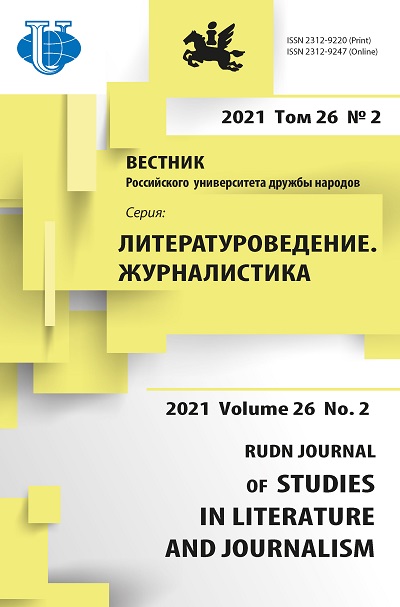Development of Popular Science Journalism in the Cross-Media Context
- Authors: Lobodenko L.K.1, Davletshina E.V.1
-
Affiliations:
- South Ural State University (National Research University)
- Issue: Vol 26, No 2 (2021)
- Pages: 262-275
- Section: JOURNALISM
- URL: https://journals.rudn.ru/literary-criticism/article/view/26942
- DOI: https://doi.org/10.22363/2312-9220-2021-26-2-262-275
- ID: 26942
Cite item
Full Text
Abstract
The development of information and communication technologies and the digitalization of the media space create new opportunities for the popularization of scientific knowledge. There is an objective need to study popular science journalism as an activity that develops a multimedia network format and various media content distribution channels. The work is aimed at analyzing the features of the development of popular science journalism on the Internet in the context of cross-media. The study employed general scientific methods (analysis and synthesis), a method of studying documents with elements of content analysis, a comparative method that includes a comparison of different types of content, as well as data from social network and messenger analytics services. The authors studied media channels and ways to promote media content, its ideological, thematic, and structural characteristics, the features of its transformation on high citation index rating’s scientific-oriented platforms Nplus1.ru and Naked-science.ru. As a result of the conducted research, it was discovered that the audience involved in the studied online media is carried out through a differentiated cross-media presence, the use of rewriting, and reposting processes. Particular attention was focused on the comparative analysis of the media content of official websites, accounts in the social network VKontakte, and Telegram messenger.
About the authors
Lidia K. Lobodenko
South Ural State University (National Research University)
Author for correspondence.
Email: lobodenkolk@susu.ru
Doctor of Philology, Head of the Institute of Media, Social Sciences and Humanities, Professor, Department of Journalism, Advertising, and Public Relations
76 Prospekt Lenina, Chelyabinsk, 454080, Russian FederationElena V. Davletshina
South Ural State University (National Research University)
Email: lobodenkolk@susu.ru
Head of the Media Relations and Monitoring Department, Associate Professor, Department of Journalism, Advertising, and Public Relations
76 Prospekt Lenina, Chelyabinsk, 454080, Russian FederationReferences
- Tertychnyj, A.A. (2013). Should there be popular science journalism? Vestnik VSU. Series: Philology. Journalism, (2), 212–217. (In Russ.)
- Bakanov, R.P. (2014). Formation of the dissemination of scientific knowledge in Russiain the 18th–20th centuries. Information Field of Modern Russia: Practices and Effects (pp. 22–40). Kazan, KU Publ. (In Russ.)
- Parafonova, V.I. (2017). Popular science magazines in the pre-revolutionary period. Mediascope (issue 3). (In Russ.) Retrieved February 12, 2021, from http://www.mediascope.ru/node/897
- Suvorova, S.P. (2013). Scientific educational topics in modern press. Vestnik Moskovskogo universiteta. Seriya 10. Zhurnalistika, (7), 128–134. (In Russ.)
- Diveeva, N.V. (2012). Scientific popularization as one of the urgent tasks of journalism in the context of high technologies and market economy. Accents. New in Mass Communication, 7–8(110–111), 13–16. (In Russ.)
- Horolskij, V.V. (2011). Popular science journalism in the information society: The inevitability of a boom. Vestnik VSU. Series: Philology. Journalism, (3–4), 13–24. (In Russ.)
- Volkova, I.I., & Guzhvij, D.A. (2017). Integrated approach to the measurement of content efficiency in new media: The setting of the problem. RUDN Journal of Studies in Literature and Journalism, 22(3), 532–543. (In Russ.)
- Makarova, E.E. (2012). Popular science sites on the Internet. Modern Journalism: Experience and Development Prospects: Materials of the International Scientific and Practical Conference (pp. 90–97). Moscow, IGUMO & IT Publ. (In Russ.)
- Pushkarev, A.A. (2016). Popular science journalism on the Internet as a tool for the development of scientific and technological progress in the Russian Federation. Ideas and Innovations, 6(3), 91–97. (In Russ.)
- Synbulatova, A.R. (2015). Specificity of popular science journalism about nature on the multimedia resources of the Runet. Mediasreda, (10), 63–70. (In Russ.)
- Suvorova, S.P. (2009). Scientific and popular science journalism: Features of the subject area, functions, tasks. Vestnik Moskovskogo Universiteta. Seriya 10. Zhurnalistika, (6), 14–23. (In Russ.)
- Popovec, L.A. (2018). Popular science journalism: Entertainment or education? The Age of Information, 1(2), 124–125. (In Russ.)
- Zhenchenko, M. (2016). Evolution of the terms “multimedia”, “cross-media”, “transmedia” in the development of digital storytelling. Media Studies, (4), 113–119. (In Russ.)
- Ljubanovskaja, J.O. (2018). Cross-media coverage in the aspect of the conflict of regional media interests. The Age of Information, (2–2), 264–265. (In Russ.)
- Zajcev, M.L. (2020). Phenomena of transmedia in the mass information process. Journal of the Belarusian State University. Journalism and Pedagogics, (1), 16–20. (In Russ.)
- Davidson, D. (2010). Cross-media communications: An introduction to the art of creating integrated media experiences. Carnegie Mellon University Pittsburgh: ETC Press.
- Hayes, G. (2006). Cross-media in Personalizemedia: Weblog by Gary Hayes. Retrieved March 11, 2021, from http://www.personalizemedia.com/articles/cross-media/
- Kachkaeva, A.G., & Shomova, S.A. (Eds.) (2017). Multimedia journalism. Moscow, HSE Publishing House. (In Russ.)
- Pashhenko, N.A. (2019). Crossmedia in travel journalism (on the example of the program TC VETTA “Accessible Ural”). Student and Science (Humanities Cycle) (pp. 673–679). Magnitogorsk, MGTU Publ. (In Russ.)
- Kalinina, L.V. (2014). Verbal competition in the Internet space: Advertising, rewriting, repost. Herald of Vyatka State University, (3), 80–88. (In Russ.)
Supplementary files















